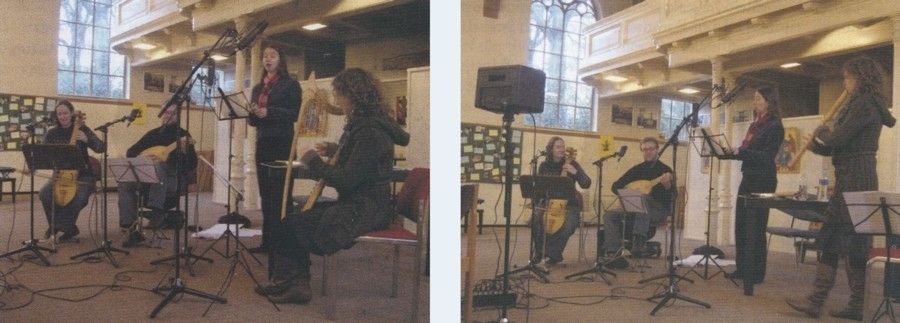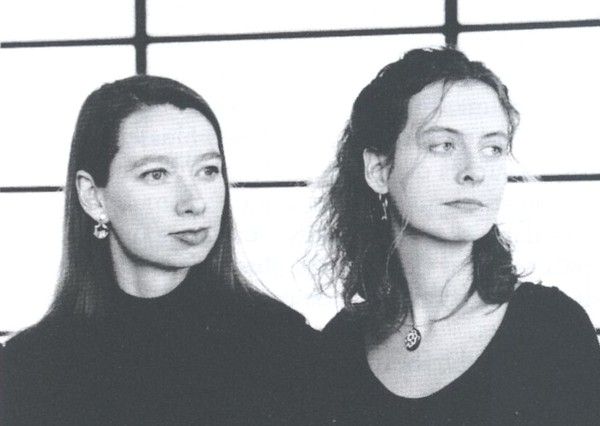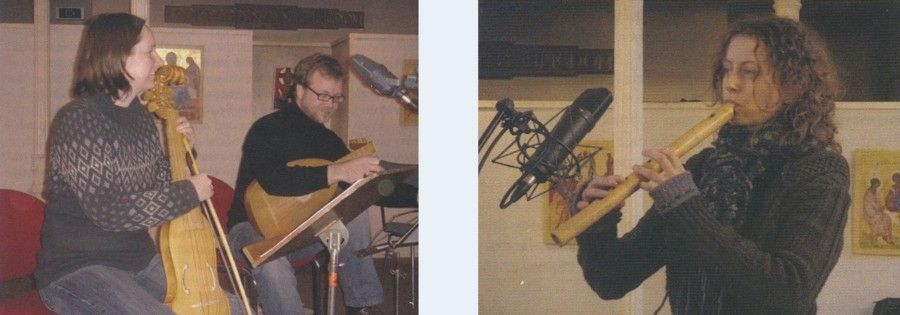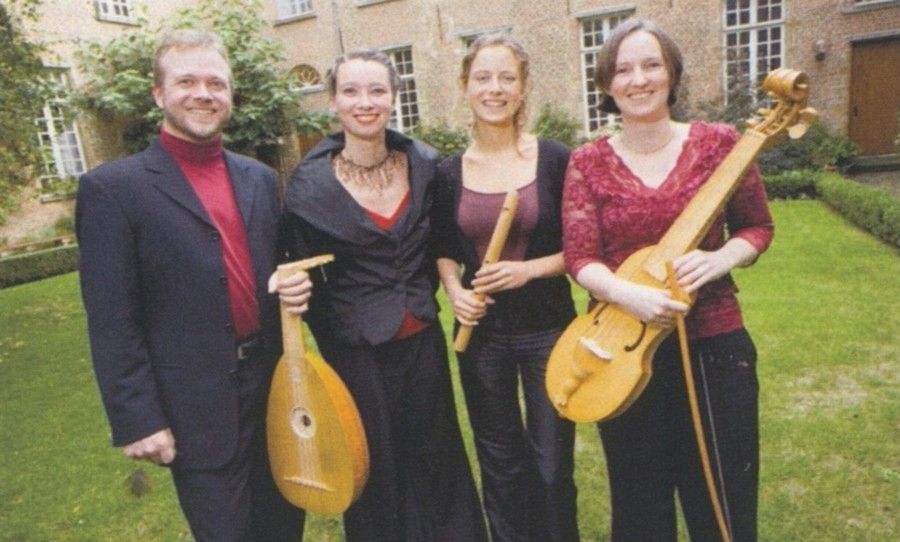Danse et Chanson / Grand Désir

granddesir.com
medieval.org
ACD HJ 043-2
2009
1. Guillaume DuFAY. Or me veult de bien [4:03]
2. Maitresse [1:53]
3. Gilles BINCHOIS. L'ami de ma Dame [4:08]
4. Vil lieber zit. Jo götz [1:04]
5. Vil lieber zit [0:57]
6. Conrad PAUMANN. En Avois [1:47]
7. Marc LEWON. Corona [3:07]
8. Triste Plaisir (Basse Danse) [1:39]
9. Gilles BINCHOIS. Triste Plaisir [3:55]
10. Modocomor [2:40]
11. Modocomor Bystu die rechte [2:38]
12. Johannes OCKEGUEM. Petitte Camusette [1:52]
13. Aspasia NASOPOULOU. Ballad I (2005) [6:13]
14. Aspasia NASOPOULOU. Ballad III (2005) [4:00]
15. Gilles BINCHOIS. Dueil angoisseux [2:18]
16. Franckurgenti [1:22]
17. Guillaume DuFAY. Franc cuer gentil, sur toutes gracieuse [4:13]
18. Filles a marrier (Basse Dance) [2:04]
19. Filles a marrier [1:12]

Grand Désir
Anne-Marieke Evers & Anita Orme Della-Marta
Anne-Marieke Evers, Mezzo-Soprano
Anita Orme Della-Marta, Recorder / Harp
Marc Lewon, Lute
Elizabeth Rumsey, Viola d'Arco / Recorder
Stephanie Brandt, Recorder (track 10, 11)

Recording date: December 3, 4, 5 & 6 2008
Recorded at the Lukas Church, Ermelo,
by Skarster Music Investment C.V.
Production & distribution: Skarster Music Investment
Producer: Jos Boerland
Recording, editing and mastering: Jos Boerland
Cover & Design: Jos Boerland
Text: Anthony Fiumara & Anita Orme Della-Marta
English translation: Anita Orme Della-Marta
French translation: Frédéric Dorfmann
German translation: Christian Salewski & Marc Lewon
Ⓟ & © 2009 by Aliud Records, Skarster Music Investment
www.aliudrecords.com
www.skarstermusic.com

Grand Désir | Danse et Chanson
De basse danse is een
statige hofdans die een eeuw lang floreerde vanaf het midden van de
vijftiende eeuw. De oorsprong van het genre ligt waarschijnlijk in
Bourgondië, maar de basse danse vond weerklank aan verschillende hoven
in Europa. De term wordt al gebruikt in een gedicht van de uit Toulouse
afkomstige priester, monnik en troubadour Raimon de Cornet (ca. 1320),
maar over de exacte danspassen vinden we niets tot de vroege vijftiende
eeuw.
De twee belangrijkste bronnen voor de muziek van de Franse
basse danse zijn te vinden in een manuscript in Brussel (Bibliotheque
Royale de Belgique, Ms 9085, ca.1470) en in L'art et instruction de bien danser
(ca. 1496) van Michel Toulouze: beide manuscripten uit de late
vijftiende eeuw, beide terugblikkend op de muziek van eerder die eeuw.
Samen met nog een aantal kleinere bronnen bevatten deze handschriften
ongeveer vijftig cantus firmi, die in lengte variëren tussen de
vierentwintig en tweeënzestig noten, genoteerd in trage semibreves
zonder ritmische variatie. Waarschijnlijk diende bij de basse danses de cantus firmus
in lange notenwaarden in de tenor als eenstemmige basis voor
meerstemmige instrumentale improvisatie. Het bewijs voor die praktijk is
te vinden in enkele uitgeschreven meerstemmige voorbeelden,
bijvoorbeeld dat op de tenor-melodie Re di Spagna.
In zijn
studie over de basse danse wijst musicoloog Daniel Heartz in verband
met het uitvoeringstempo op de relatie tussen de muziek en de
daadwerkelijke gedanste passen: elke noot van de basse danse-melodie
correspondeert volgens hem met één figuur van de dans. Die figuren
bestonden ieder uit vier bewegingen van gelijke duur, terwijl de
begeleiding zes tellen besloeg. De dansers bewogen dus in twee tegen
drie ten opzichte van de muziek, op hun tenen, in een golvende beweging.
Het
Brusselse basse danse-manuscript verklaart de naam van het genre uit
het karakter van de gedanste figuren: “Et se nomme basse danse [...]
pour ce que, quant on la danse, on va en paix sans soy demener, le plus
gracieusement que on peut”. Met andere woorden: de dans bestond uit
niets anders dan een rustig schrijden, zo bevallig mogelijk en zonder
verdere gestes.
In het al eerder genoemde gedicht van Raimond de
Cornet, de eerste melding van de basse danse, stelt hij: “Een jongleur
leerde snel stanza's en vele kleine verzen, cansos en basses danses”.
Door de basse danse in een adem te noemen met een aantal gezongen
genres, lijkt het hier alsof de basse danse in oorsprong vocaal werd
uitgevoerd, al zijn geen voorbeelden van overgeleverd.
Dat de
verbinding met de vocale muziek wel degelijk te leggen is, bewijst deze
cd. Geinspireerd door het onderzoek van Frederic Crane naar de basse
danse, bevat deze cd een aantal cantus firmi, of fragmenten
daarvan, die een gelijkenis tonen met enkele tenoren van chansons uit
dezelfde tijd. Hierdoor wordt de vraag naar de oorsprong van deze cantus firmi meer dan slechts een vraagteken.
In de tenoren van Maitresse en Triste Plaisir is bijvoorbeeld een gelijkenis van een aantal noten te vinden in vergelijking met de chansons L'ami de ma Dame en Triste Plaisir. Een grotere overeenkomst is te vinden in de tenor Portugaler. In vergelijking met Dufay's chanson Or me veult de bien esperance mentir (dat op zijn beurt weer over dezelfde tenor geschreven is als Dufay's Portugaler)
komen de eerste acht noten van de dans met het chanson overeen. Hoewel
de meeste basse danses overeenkomsten laten zien tussen de tenor-lijnen
van de dans en het chanson, toont de tenor van de basse danse Filles a marrier juist een bijna gehele gelijkenis met de cantus van het gelijknamige chanson.
Niet
alleen de oorsprong van de basse danses vraagt om opheldering, maar ook
de uitvoeringspraktijk daarvan. Slechts enkele voorbeelden van
diminuties over een basse danse tenor zijn uit de late 15e eeuw
overgeleverd (ervan uitgaand dat onze tenoren inderdaad als tenoren
bedoeld waren en niet als volwaardig uitgeschreven composities). De
stijl waarin Grand Désir hun basse danses uitvoert, is een samensmelting
van verschillende factoren zoals basiskennis van de choreografie van de
basse danse, overgeleverde diminuties gecomponeerd over basse danse
tenoren en de stijl van diminuties die gebruikt wordt in verschillende
15e eeuwse bronnen met instrumentale bewerkingen (zoals de Fundamentum Organisandi van Conrad Paumann en het Buxheimer Orgelbuch).
Afgezien van Filles a marrier
zijn de verdere chansons op deze cd gecomponeerd door Guillaume Dufay
en Gilles Binchois, twee van de grootste componisten van de 15e eeuw. De
chansons zijn naar de traditionele poëtische vormen van de formes fixes gecomponeerd en laten een enorme variatie aan textuur zien, vooral door hun complexe ritmiek en motieven.
Zoals
de vijftiende-eeuwse basse danse, het chanson en de intavolaties van
die chansons op deze cd naar elkaar verwijzen en met elkaar verweven
zijn, zo componeerde de uit Griekenland afkomstige componiste Aspasia
Nasopoulou tenslotte een actueel antwoord op die oude vormen. Dat begint
als bij de titel Ballad, die verwijst naar de narratieve liedvorm die
sinds de Middeleeuwen bekend was. Oorspronkelijk refereerde de ballade
aan dansliederen, maar bij Nasopoulou is het een sololied met
begeleiding. Zoals Gilles Binchois al deed, gebruikte de Griekse
componiste ook voor haar werk de lyrische poëzie van Christine de Pizan
(ca. 1364 — ca. 1430), een van de eerste vrouwen met een professionele
literaire carrière. Pizans persoonlijk getinte gedichten en de
combinatie met het oude instrumentarium vormden voor Nasopoulou de
inspiratiebron voor een nieuwe invalshoek voor beide gegevens. De
componiste liet zichzelf naar eigen zeggen leiden door de emoties en
beelden van de gedichten, maar ook door de pure klank van de
instrumenten.
De archaïsch aandoende, verstilde composities van
Nasopoulou contrasteren niet eens zo fel tussen de vroege
renaissancemuziek. Met haar polyfone gemeander bleef de Griekse dicht in
de buurt van de oude muziek. Zeker in het geval van de eerste Ballad,
waar ze verschillende middeleeuwse modi gebruikte — de tweede
contrasteert wat dat betreft door zijn chromatische karakter. Toch
klinken de twee Ballads ontegenzeggelijk als van deze tijd: golvend van
ritmiek en kruidig van toonmateriaal ademen de half gesproken, half
gezongen liederen herinneringen aan een gedroomd verleden.

Grand Désir | Danse et Chanson
The basse danse is a
stately courtly dance whose origin can be traced to Burgundy. It was
enthusiastically taken up at numerous courts throughout Europe and
flourished for a century long from the middle of the 15th century
onwards. That courtly dance existed before this is clear: for example, a
description of the basse danse can be found as early as ca. 1320, in a
poem by the Toulousain priest, friar and troubadour Raimon de Cornet. No
information however concerning its choreography can be found until the
early 15th century.
The Brussels (Bibliotheque Royale de Belgique, Ms 9085, ca.1470) and Toulouze (L'art et instruction de bien danser, ca. 1496, by Michel Toulouze) manuscripts are the two most important musical sources of the French basse dance;
although both manuscripts are dated to the late 15th century,
stylistically their music resembles the earlier decades of the century.
These manuscripts, along with a few additional sources, contain around
fifty cantus firmi, varying in length between twenty-four and
sixty-two notes, notated in slow semibreves without rhythmical
variation. It is assumed that the cantus firmi of these basse
danses notated in long semibreves provided a monophonic basis for
polyphonic instrumental improvisation. Evidence for such a practice can
be found in some polyphonic examples written out on the tenor-melody Re di Spagna.
Regarding
performance-tempo, Daniel Heartz points towards the relation between
the music and the actual choreography in his study concerning the basse
danse: according to Heartz, each semi-breve of the basse danse-melody
corresponds to one figure in the dance. Each figure consisted out of
four movements equal in length, while the musical accompaniment took up
six beats. Thus, the dancers moved fluidly on their toes in a
three-to-two proportion to the music.
An explanation to the
origin of the basse danse's name can be found in the Brussel manuscript
and refers to the character of the dance: “Et se nomme basse danse [...]
pour ce que, quant on la danse, on va en paix sans soy demener, le plus
gracieusement que on peut”. Thus, the dance consisted of nothing more
than calm striding, as graceful as possible without further gestures.
The
first reference to the basse danse in the poem by Raimond de Cornet
mentioned in the first paragraph stated: “An enchanter quickly memorized
stanzas and small versus, cansos and basse danses”. By mentioning the
basse danse in one breath with some sung genres, could suggest that the
basse danse was originally performed vocally, although no examples of
such a practice still exist.
That a connection can be made to
vocal music, is suggested by the present recording. Inspired by Frederic
Crane's research on the basse danse, this CD contains a number of cantus firmi and fragments of cantus firmi, which show striking resemblance to the ‘tenors’ of some contemporary chansons, turning the question of these cantus firmi's origin into more than just mere speculation.
The ‘tenors’ Maitresse and Triste Plaisir, for example, share a few notes with their associated Chanson L'ami de ma Dame and Triste Plaisir. The ‘tenor’ Portugaler shows a greater resemblance to Dufay's chanson Or me veult de bien esperance mentir (which shares the same tenor as Dufay's Portugaler) in that the first eight notes are similar. Unlike most basse danses that show resemblance with the tenor-lines of their associated chansons, the basse danse Filles a marrier shows almost complete similarity to the cantus of its chanson.
However
it is not just the origin of the basse danses that arouses speculation,
but also their performance practice. Few examples of composed
diminutions over basse danse tenors have survived from the second decade
of the 15th century (presuming that our tenors are indeed meant to
serve as such and not as a completed composition). The style in which
Grand Désir performs the basses danses has therefore been determined by
several factors such as basic knowledge of the basse danse choreography,
some surviving examples of diminutions written over basse danse tenors
as well as the style of diminutions used in several 15th century sources
of intabulations (such as Conrad Paumann's Fundamentum Organisandi and the Buxheim Organbook).
Apart from Filles a marrier,
the chansons presented on this CD have been composed by Guillaume Dufay
and Gilles Binchois, two of the greatest composers of the 15th century.
The musical forms of the chansons follow the traditional poetical forms
of the so called formes fixes and their chansons show an extreme variation of texture, mostly due to complex rhythms and motives.
A
contemporary answer to the 15th century basse danses, the chansons and
their intabulations, was composed by the Greek composer Aspasia
Nasopulou - the title Ballad already referring to a narrative song known
since the middle ages. Originally the term Ballad referred to
dance-songs, but Nasopulou's Ballad is a solo-song with accompaniment.
Like the composer Gilles Binchois, the Greek composer also used the
lyrical poetry by Christine de Pizan (ca. 1364 — ca. 1430) for her
compositions. Pizan was remarkable for being one of the first women with
a professional literary career. Nasopoulou used Pizan's subjectively
coloured poetry combined with early instruments as a source of
inspiration. This allowed for the creation of a new point of view
towards various elements. Quoting the composer herself, she was led by
the emotions and images of the poetry, but also by the pure sounds of
the instruments.
The archaich and tranquility immanent in the
compositions by Nasopulou do not contrast vigorously to the early
renaissance music. With her polyphonic meander, the Greek composer
remained close to early music. This is especially evident in the first
Ballad in which she used several medieval modi. The second Ballad
presents a pleasing contrast with its polyphonic character. In spite of
this, both Ballads sound contemporary: flowing rhythms and pungent
tonal material breathing the half-spoken, half-sung chansons reminiscent
of a dreamt past.
Grand Désir's artistic directors Anita
Orme Della-Marta (Recorder, Harp) and Anne-Marieke Evers (Mezzo-Soprano)
met at the beginning of their musical studies at the Conservatorium of
Amsterdam in September 1997, where they specialised both in contemporary
music as well as medieval and renaissance music. Later in their
careers, their paths led them to pursue further studies in medieval
music at the Schola Cantorum Basiliensis, Switzerland, where they met
the other ensemble members of Grand Désir.
Grand Désir performed
their première in the 'Fringe' programme of the Utrecht Early Music
Festival 2005. The ensemble has given numerous performances and radio
recordings since in the Netherlands, Belgium, Switzerland and Australia.
In July 2009, Grand Désir won the audience award during the York Early
Music Festival Young Artist's Competition 2009.
Grand Désir likes
to work with different musicians for each individual programme, thus
creating the flexibility to obtain the perfect instrumentation for each
project. The large repertoire of Grand Désir, as well as their interest
to combine contemporary and medieval music, makes Grand Désir a unique
ensemble both for early as well as contemporary music.






